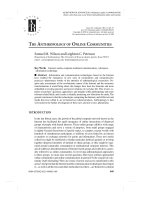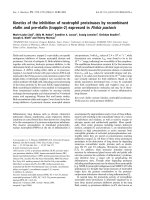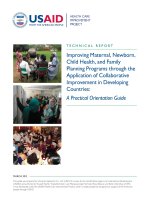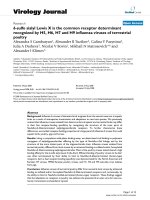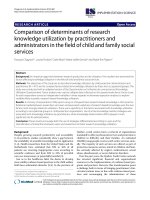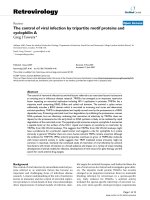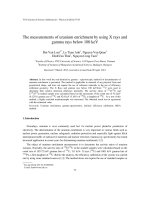The experiences of poor children beyond poverty the case of children supported by genete eyesus child and family development program
Bạn đang xem bản rút gọn của tài liệu. Xem và tải ngay bản đầy đủ của tài liệu tại đây (844.45 KB, 104 trang )
1
The Experiences of Poor Children beyond Poverty: The Case of Children Supported by Genete
Eyesus Child and Family Development Program
By
Fikru Wolde
Advisor
Ashenafi Hagos (PhD)
A Thesis Submitted to School of Social Work
Presented in Partial Fulfillment of the Requirements for the Degree of Master of Arts
(School of Social Work)
Addis Ababa University
Graduate School of Social Work
June, 2017
2
The Experiences of Poor Children beyond Poverty: The Case of Children Supported by Genete
Eyesus Child and Family Development Program
By
Fikru Wolde
PhD)
A Thesis Submitted to School of Social Work
Presented in Partial Fulfillment of the Requirements for the Degree of Master of Arts
(School of Social Work)
Addis Ababa University
Graduate School of Social Work
June, 2017
3
Letter of Declaration
I, the undersigned declare that, this is my original work and has not been presented for degree at
other university and all the source of materials used for the research project have been dually
acknowledged.
Researcher’s Name: Fikru Wolde
Signature: _____________________
Date: _________________________
Place: ________________________
Date of Submission: _____________
This thesis has been submitted for examination with my approval as the thesis advisor.
Advisor’s Name:
Ashenafi Hagos (PhD)
Signature: _____________________
Date: _________________________
4
Addis Ababa University
School of Graduate Studies
This is to certify that the thesis prepared by Fikru Wolde, entitled: The Experiences of Poor
Children beyond Poverty: The Case of Children Supported by Genete Eyesus Child and Family
Development Program submitted to Addis Ababa University School of Social Work in partial
fulfillment for the requirements of Master of Social Work complied with the regulations of the
Addis Ababa University and meet the accepted standards with respect to originality and quality.
Signed by the Examining Committee:
Examiner_________________________ Signature____________ Date _____________
Examiner_________________________ Signature____________ Date _____________
Advisor _________________________ Signature____________ Date _____________
i
Acknowledgment
All praise and glory to the almighty God, for granting me the ability and strength to
accomplish this research paper all the way through.
I would like to thank my thesis advisor, Dr. Ashenafi Hagos who helped me in preparing my
thesis and who has been guiding me with the very helpful knowledge of him. I extend my deep
respect and gratefulness. I thank all my family members for being there throughout my academic
year.
I am especially grateful to Dr. Getachew Animut. He has tirelessly assisted me showing
directions. You were extremely supportive that you were available whenever I needed your
support. I would also like to thank Pawelose for his important comments, suggestion and for
encouraging me to do this thesis.
My very special thanks go to the study participants who were willing to devote their time and
shared their experiences with me. Without their trust in answering questions, this research would
not have completed. I would like to thank Genete Eyesus Child and Family Development
Program (GECFDP) staffs for helping me by recruit study participants and giving me access to
important documents and files. I am grateful to everyone who helped me in one or another way.
Without the support I have received, I could not have completed this thesis.
Thank you very much!
ii
Abstract
This research aims to understand the experience of poor children beyond poverty who are
supported by Genete Eyesus Child and Family Development Program. Data were gathered using
in-depth interview and observation. A total of 10 respondents, between 14 to 18 years of age
were used. The research employed qualitative, descriptive phenomenological approach to
describe the experience of poor children. Children considered in this study shared their life
experience as a life lacking happiness. The children blame their families for the challenges they
face in life and for their unhappy life. The study revealed that shouldering household
responsibilities and burdens, absence of parental support, social discrimination, sexual
harassment by their own biological parent, and lack and denial of acceptance for their ideas
within the family are challenges of the children that had left a negative print in their minds. The
main challenges that poor children are facing in their daily lives include: missing basic needs,
receiving inappropriate treatment and being exposed to various types of abuses and neglect. The
study indicated that even though children are affected by lack of materials, they prioritize love
and care from parents and society as a major risk factor to their wellbeing. Children from their
own parents and caregivers in the households appear to be abused emotionally and physically.
Children who lack family love and care tried to commit suicide, desire to commit patricide and
matricide, feel lonely, depressed due to the influence they face in their household and society.
Poor children are not passive victims of various socio cultural induced challenges. They actively
employ coping strategies such as praying, peer support, and performing different mental
relaxation activities to tackle their problems. However, there is minimal counseling service and
no recreation activities in the studied organization that is necessary to help the affected children,
which requires proper intervention in the area to improve the wellbeing of the affected children.
Key words: Psychosocial Challenges, Poor Children Experience, Child Poverty
iii
Table of Contents
Acknowledgment ......................................................................................................................................... i
Abstract....................................................................................................................................................... ii
Chapter One ................................................................................................................................................ 1
1. Introduction ............................................................................................................................................ 1
1.1. Background of the Study .................................................................................................................. 1
1.2. Statement of the Research Problem .................................................................................................. 3
1.3. Objectives of the Study .................................................................................................................... 5
1.3.1. General Objective ..................................................................................................................... 5
1.3.2. Specific Objectives of the Study ............................................................................................... 5
1.4. Research Question ............................................................................................................................... 5
1.5. Significance of the Study ..................................................................................................................... 6
1.6. Scope of the Study ............................................................................................................................... 6
1.7. Organization of the Paper .................................................................................................................... 7
1.8. Definition of Terms.............................................................................................................................. 7
Chapter Two ............................................................................................................................................... 9
2. Literature Review ................................................................................................................................... 9
2.1. Concepts of Child Poverty ............................................................................................................... 9
2.2. Children in Poverty ........................................................................................................................ 10
2.3. The Gender Faces of Poverty ......................................................................................................... 14
2.4. Poor Children Challenges .............................................................................................................. 16
2.4.1. Psychosocial Challenges ............................................................................................................. 16
2.4.1.1. The Challenge of Poverty on Social Relationships ............................................................... 18
2.4.1.2. The Health and Emotional challenge of Poverty .................................................................. 18
2.4.1.3. Poverty and Social Exclusion among Children .................................................................... 19
2.4.2. The Economic and Material Challenge ....................................................................................... 21
2.5. Needs of Poor Children .................................................................................................................. 23
2.6. Causes of Increases in Childhood Poverty and Combating Child Poverty ..................................... 24
2.7. Coping Strategies of Poverty by Children ...................................................................................... 25
Chapter Three ........................................................................................................................................... 27
3. Research Methods ................................................................................................................................. 27
3.1. Philosophical Paradigm .................................................................................................................. 27
3.2. Study Area ..................................................................................................................................... 28
3.3. Research Design............................................................................................................................. 29
3.4. Sampling Technique ...................................................................................................................... 31
iv
3.4.1 Sample Size .............................................................................................................................. 31
3.4.2 Inclusion Criteria...................................................................................................................... 32
3.5. Method of Data Collection ............................................................................................................. 32
3.5.1. In - depth Interview ................................................................................................................. 33
3.5.2. Observation ............................................................................................................................. 33
3.6. Method of Data Analysis ................................................................................................................... 35
3.7. Quality Assurance .............................................................................................................................. 36
3.8. Ethical Consideration ......................................................................................................................... 36
3.9. Challenge of the Study ....................................................................................................................... 37
4. Data Presentation .................................................................................................................................. 38
4.1. Psychosocial Challenges That Affect Poor Children – Children Experience ................................. 38
4.1.1. Poor Children past Life Challenges ......................................................................................... 38
4.1.2. Current Challenges of Poor Children ...................................................................................... 42
4.1.3. Adverse Situation of Psychosocial Challenges to Poor Children............................................. 47
4.1.4. Children Aspiration ................................................................................................................. 50
4.2. Poor Children Psychosocial and Material Need ............................................................................. 52
4.2.1. Psychosocial Need .................................................................................................................. 53
4.2.2. Material Need.......................................................................................................................... 60
4.3. Coping Strategy ............................................................................................................................. 61
4.3.1. Peer Support ............................................................................................................................ 61
4.3.2. Undertaking Mental Relaxation Activities .............................................................................. 62
4.3.3. Praying .................................................................................................................................... 63
Chapter Five ............................................................................................................................................. 65
5. Discussion ............................................................................................................................................. 65
Chapter Six ............................................................................................................................................... 69
6. Conclusion and Social Work Implication.............................................................................................. 69
6.1. Conclusion ..................................................................................................................................... 69
6.2. Social Work Implication ................................................................................................................ 70
6.2.1. Implication for Practice ........................................................................................................... 70
6.2.2. Implication for Policy ............................................................................................................. 72
6.2.3. Implication for Research ......................................................................................................... 72
Reference
Annexes………………………………………………………………………………………….vii
v
Acronyms and Abbreviations
AA
Addis Abeba
GECFDP
Genete Eyesus Child and Family Development Program
CSA
Central Statistics Authority
NGOs
Non-Governmental Organization
GOs
Governmental Organization
CBOs
Community Based Organization
vi
List of Table
Table 1- Socio-Demographic Information of Children Participated in In-Depth
Interviews. .......................................................................................................... viii
List of Map
Figure 1: Map of the study area woreda 2 (kebele 03/04) ................................................. 29
1
Chapter One
1. Introduction
1.1. Background of the Study
Anku (2012, p.12) defined child poverty as “lacking the resources necessary to obtain the
types of diets, participate in the activities, and have the living conditions and amenities that are
customary in the societies to which they belong”. Such resources include money, but may also
include other forms of material resources such as access to healthcare, a decent home and a
quality education. Gordon, Nandy, Pantazis, Pemberton and Townsend , (2003), pointed out
that over one billion children, that is more than half of the children in developing
countries suffer from severe deprivation of basic human needs and over one third (674 million)
suffer from absolute poverty. It is also argued that the timing, depth and duration of poverty have
a pivotal role on the effect poverty induces on the lives of children (Duncan and Brooks-Gunn,
and Duncan 1997).
There are many studies that focused on material aspect of child poverty. However, little
attention have been given for children to prioritize and express their own problems not only in
terms of material poverty but also regarding to other psycho social challenges that impact their
wellbeing. Moreover, there is a lack of consideration of the possible root causes of child welfare
associated with household, neighbor, school and other social environments that the child
interacts with and the cultural issues that affect the psychological development of the child.
Related to this, Tatek, (2008), noted that views of children to poverty are seldom heard, but
photographs and stories about them are very common. Similarly, Yisak, (2012), described that
despite huge engagement by policymakers, changes in child poverty are very limited, a possible
2
reason, among many others, is the very limited consideration of children‟s views in policy
formulation and interventions as there may be diverse factors that affects child development
beyond poverty.
Tatek, (2008), mentioned that the long tradition of childhood studies considers children
as incompetent and believes that they need to be adults before their ideas are considered.
Changing this notion and learning from the young is, however, key and can help us broaden our
knowledge base to design better and effective interventions. Feeny and Boyeden, (2004),
indicated that tackling child poverty is a huge and complex task, and involves somewhat of an
exercise in humility on two distinct levels; firstly, in recognizing the cultural biases and
assumptions on which current approaches rest; and secondly, in understanding that the
eradication of child poverty by virtue of its far-reaching linkages, is not something we are likely
to achieve quickly, easily or without the active involvement of others particularly those of the
children themselves. Most of the studies such as (Anku, 2012, Duncan and Brooks-Gunn, and
Duncan 1997, Yisak, 2012) have focused on repeatedly treating the symptoms and effects of
material poverty, without due consideration of the views of children regarding to psychosocial
issues that affect poor children.
This study was conducted in Genete Eyesus Child and Family Development Program
(GECFDP) with the aim of assessing and describing experiences of poor children to
psychosocial challenges that impact child growth and development. Data for this study was
gathered from GECFDP, the program has been rendering service for highly vulnerable children.
The target group of the program consists of 1600 enrolled children who are exposed to and /or
are victims of different problems. The children consist of 0-5 years, 6-14 years, and 15-24 years
of age. The study was assess positive and otherwise experiences of children that can affect their
3
lives beyond children‟s felt need. As children are in a better position to tell policy makers,
organization who work with children and other concerned bodies, involving them directly in
such studies and learning from their experiences is expected to generate fruitful information
helpful to design strategies to fight child poverty and psychosocial difficulties.
1.2. Statement of the Research Problem
There have been many studies done on the various dimensions of child poverty. Studies
by Eamon (2001), Treanor (2012), Evans and Kim, (2013), identified that material poverty has a
negative impact on children‟s health, cognitive development, social, emotional, and behavioral
development, and on educational outcomes, which consequently lead to physical and
psychosocial stress. The work of Meyer, (2014), on the effects of childhood poverty on adult
health outcomes showed that children who grow up in lower socio economic homes often have
fewer advantages available to them including level and quality education, quality health care and
family support that impacts adult health outcomes, adult employment, earnings and adult socio
economic status. Another study conducted by Ridge, (2009), showed that children on material
impoverishment are prone to socio-economic problems.
There are researches conducted to assess effect of family income on child poverty.
Family income has quite substantial effects on child and adolescent well-being (Duncan, Gunn,
Yeung and Smith, 1998), on the vulnerability of children to abuse and exploitation (Ridge,
2007), and on an overall suffering from income poverty (Bastos, Fernandes, Passos,
2004).Ridge, (2002), conducted a research on childhood poverty and social exclusion, and
demonstrated that poor children seem to feel more conspicuous, self-conscious and worried
because of their background. Anku‟s, (2012), study on children‟s perspectives of poverty and
4
livelihood strategies in Ghana, noted that children have different explanations and understanding
of poverty and children‟s experiences of poverty are connected to the kind of employment their
parents or caregivers are engaged in, and the number of siblings that the child has in his or her
family.
Few studies on child poverty have been conducted in Ethiopia. Yisak, (2012), carried out
a research on child poverty and illustrated that children‟s were more victims of the consequences
of poverty while they rarely contributed to its causes. Similarly, Yisak, (2014), conducted on
children‟s experiences of household poverty and found out that there is no guarantee that positive
changes in family economic status bring about changes in the wellbeing of children.
Ajebush, (2010), conducted a research on childhood poverty and noted that despite some
progress over the last few decades, life for many of Ethiopian children remain short, poor,
insecure and violent. The finding of Freweini, (2013), illustrated that focusing on food aid and
investing on nonfood items to be vital in reducing child poverty. EDRI, (2013), conducted a
research on reducing childhood poverty in Ethiopia and found out that a strong need for public
preprimary education in Ethiopia to reduce poverty. Related to experience of poor children only
few studies were conducted in Ethiopia among this Bethlehem, (2009), explored the lives of
Kolfe area children living in poverty and noted that the majority of the children perceive that
relationships that are characterized by conflict are more damaging than material poverty.
However, this study only used children of the age category between11 and 14, and lacks to
provide the multitude of other aspects of poverty impacting children‟s lives, such as the various
psychosocial challenges that can affect child wellbeing.
5
Generally, despite the various studies that has been conducted on child poverty, the
majority of those have focused only on the material aspect, and research endeavors that target the
psychosocial challenges impacting child wellbeing on the one hand and learning from the
experiences of the children themselves on both impact of poverty and psychosocial challenges
have not been addressed well. Therefore, this study is designed to address the experiences of
poor children to psychosocial challenges who are supported by Genete Eyesus Child and Family
Development Program (GECFDP).
1.3. Objectives of the Study
1.3.1. General Objective
The main objective of the study is to assess experiences of poor children to psychosocial
challenges who are supported by Genete Eyesus Child and Family Development Program
(GECFDP).
1.3.2. Specific Objectives of the Study
To find out psychosocial challenge that affect poor children lives who are
supported by Genete Eyesus Child and Family Development Program (GECFDP).
To examine poor children‟s psychosocial and material needs.
To assess the coping strategies employed by the children to psychosocial induced
challenges.
1.4. Research Question
-
What are poor children experiences to psychosocial challenges that impact child
wellbeing?
6
1.5. Significance of the Study
Taking into account the scarcity of information related to poor children‟s experiences
beyond poverty in Ethiopia, this study will make a contribution to the working knowledge so far
developed and fill to the national knowledge gap in the area and provide scientific based
information on the issue. The lives of poor children cannot be fully understood by only
emphasizing on material poverty unless giving due attention on their real priorities and concerns.
Thus, the study will have a paramount importance to reveal and understand on issues that
concern children beyond material poverty to help solve their multifaceted problems and improve
their wellbeing.
The result of this study may also help organizations and other concerned bodies working
with poor children for effective mobilization of resources, and efficient use of internal and
external resources to develop strong, child centered and sustainable programs that respond well
to meet the needs and priorities of poor children. Moreover, it is hoped that the results of this
study will serve as a springboard for wider research engagement by other researchers to help
develop fact based recommendations useful to put in place interventions that would bring a
positive and significant impact in the lives of the poor children.
1.6. Scope of the Study
The scope of this research is limited to poor children experiences beyond poverty in
Genete Eyesus Child and Family Development Program (GECFDP). The study focuses on
assessing experiences of poor children to psychosocial challenge embraced in the mentioned
program. However, the study was not cover experiences of children‟s peers. With regard to the
age of the study participant, the study was cover children between the ages of 14-18 years.
7
1.7. Organization of the Paper
This paper is structured in six Chapters. The first Chapter includes the introduction,
statement of the problem, research objective, and research questions. Additionally, it discussed
the scope, significance, and provides the definition of important terms used in the study. It
provides preliminary information about child poverty in general. The second Chapter is
dedicated to literature review that shows the experience of different countries and findings of
different authors and gives a general overview of child poverty. The third Chapter describes the
methods that were employed in the study; how data was collected and analyzed, data quality
assurance and ethical considerations. The fourth Chapter provides the data presentation and
major themes that were emerged from the qualitative data gatherings. The major themes are life
in poverty- children experience, adverse situations of poor children, poor children main priority
and coping strategy employed by children. The fifth Chapter discusses the above mentioned
major themes by comparing and contrasting them with the findings of prior studies. The final
Chapter is dedicated to conclusion and social work implications.
1.8. Definition of Terms
Child Poverty - It is defined that lack of access to tangible basic needs such as food, water,
sanitation, nutrition and health, education, as well as child love and care (Ajebush, 2010).
Coping- defined as efforts to restore or maintain internal external equilibrium under significant
threat by means of humanities including thought and action (Smith and Carlson, 1997).
Wellbeing- a concept that brings together the „subjective‟ (“values, perceptions and
experience”), „material‟ (“practical welfare and standard of living”) and „relational‟ (“personal
and social relations”) dimensions of people‟s lives (White, 2008, p.7).
8
Psychosocial Challenges- It is defined that variety of psychosocial problems include death of a
loved one, domestic violence, physical or sexual abuse, social distress, or stigmatization,
experiencing a traumatic event, or a combination of this factors (Jordans, 2003).
Beyond Poverty- For the purpose of this study beyond poverty refers to the psychosocial
aspects of poor children further than their material poverty.
Material Impoverishment- For the purpose of this study material impoverishment refers to the
monetary items that poor children lacks.
9
Chapter Two
2. Literature Review
In this chapter studies conducted in the area of child poverty and coping strategies they
use both at local and international level are reviewed. Accordingly, it begins with definition of
the term child poverty and followed by the presentation of different child poverty perspectives.
2.1. Concepts of Child Poverty
Child Poverty is a broad object of research that can be defined in several ways.
Freweini, (2013), defined child poverty is about children living in households suffering from a
lack of material resources. It is usually conceived as the poverty experienced by children and
young people. It differs from adult poverty in that it can have different causes. Ajebush, (2010),
also defined that lack of access to tangible basic needs such as food, water, sanitation, nutrition
and health, education, as well as child love and care.
Child poverty also defined by Anku, (2012), provides a relevant insight or definitions of
poverty by children‟s themselves and they defined that poverty is caused by shortage of proper
diet, low level of living conditions such as dilapidated house conditions, poor light system,
uncomfortable furniture, non-illuminated rooms, financial problems to afford children‟s needs to
supply them with basic and vital supplements. Quarrels arise among the siblings of the same
family due to insufficient supply during meal time. Likely, Yisak (2012) also revealed that
children‟s definitions of poverty relate to the lack of basic necessities such as food, clothing and
proper housing.
10
2.2. Children in Poverty
There are various studies conducted on the children poverty among this, Ridge, (2009),
described poverty of children as having a wide range of impact on children‟s lives penetrating
itself in various ways among peers and neighbors. These again lead to children‟s being alienated
and stigma associated with fear and sadness. Likewise, Treanor, (2012), expressed that children
in poverty face various economic setbacks throughout their lives. Anku, (2012), adds that
wearing of worn-out clothes and shoes affects the psychological dignity by causing a feeling of
shame. Moreover, this situation is aggravated as they live in very confined and dilapidated
residences.
Research conducted in Uganda by Witter and Bukokhe, (2004), also focused on
children's understanding of poverty and found that children have a broad and rich understanding
of the nature and causes of poverty compared with adults, they appear to place more emphasis on
personal and family factors. Children also see poverty as inherited, but not uniformly and
inevitably; they identify ways in which 'rich' children can be poor, in a wider sense.
The other research conducted in India by Bourdillon and Boyden, (2012), reveals that
children conceive material inequalities as indicator of wider differences in power and position
where they themselves are a part. According to this research children‟s understanding of poverty
differs very much than that of the adults. Children‟s explanations of varied access to services
conduced that the haves families had more options to quality services while the poor families
have much less alternatives.
Research carried out in European countries portrays that limited financial resources,
joblessness and being not well literate are very challenging. Children in this continent suffer
11
twice as hard. According to Ridge, (2007), a key issue for many children in the study was
the type and quality of childcare available for them. Where childcare worked for children it
was a valuable social experience, but for most of the children who had to use it childcare was an
area of dissatisfaction and concern.
There is a study focusing on the relationship between poverty and child neglect
conducted in Canada by Schumaker, (2012), and showed that while poverty related need on its
own does not explain the high proportion of poor families investigated for reasons of neglect by
the child welfare system, nor does it account for significant variance in the decision to provide
ongoing services or to place a child in out of home care. On contrary to this, a research
conducted by Garrett, Ng'andu and Ferron, (1994), described families stressed by poverty should
generally provide a home environment less supportive of child development than family‟s
enjoying adequate incomes.
The other research conducted in Poland by Tarkowska, (2005), depicts that children
living in poverty are underprivileged children, "children without hope,” as they tend to be called
bitterly. Children brought up in poor families are undernourished, insufficiently clad, they live in
worse conditions, have worse grades and are under-prepared for adulthood. They also have far
worse perspectives for the future. Redmond, (2008), argues based on children experience that
economic disadvantage can lead to exclusion in a number of critical areas, including schooling,
access to out of school activities, and interaction with peers.
Lewit, (1993), described that poor children encounter multiple problems during their
childhood. They are more likely than their more affluent counterparts to go hungry, to be
inadequately housed and clothed, and to receive inadequate medical care as well as insufficient
12
social support. Poor children face increased risk of death, infectious and chronic illness, and
injury from accidents and violence.
Studies also illustrated that relations have to do with opportunities for children to
negotiate structural aspects of social relations, through the exercise of their autonomy in addition
material resources, physical environment and home, security and autonomy are highlighted in the
findings. According to Fattore, Mason and Watson, (2007), experiences of some children may
reflect dimensions and domains valued by children such as social relations play in children's
experiences of wellbeing from participating in activities. Likely, Camfield and Woodhead,
(2008), interaction with others: family, peer group and institutions (school) have impact on
avoiding risks and keep safe for children‟s well – being.
According to Jarjoura, Ruth, Triplett and Gregory, Brinker, (2002), children raised in
poverty are less likely to perform well academically, are more likely to report lower levels of
self-confidence, and are less likely to be supervised effectively by parents. These children are
also more likely to grow up in families that lack the resources or skills needed by children and
contribute to a higher likelihood of delinquent participation.
The literature on child poverty is also described that without the care or protection of
adult figures such as a mother and father, children are automatically and especially vulnerable to
malnutrition, disease and death. The immediate, nuclear family is viewed as the „best‟ place for a
growing child, and those who live in other domestic arrangements for whatever reason - are
seen to be deprived (Mann, 2001).
Without efforts to reduce disparities in the distribution of incomes and assets as well as
specific policies to ensure access to basic social services of good quality for the poor, economic
13
growth cannot guarantee improvement in quality of life for all. In many cases economic growth
coexists with inequality sufficiently severe to prevent the most vulnerable from benefiting, and
may even increase child poverty among excluded social groups (Boyden and Levison,
2000).Deprivation is a general condition for the child and spans a far greater period of time, e.g.
in some cases, their whole lives (Goodhand, 2001).
Child poverty argument increasingly tends to be used by some as justification for child
prostitution and the inaction of government bodies. In this regard, Lean Lim, (1998), described
that the sex tourist an easy opportunity to avoid feelings of guilt –by paying for a child‟s
services, he/she can convince themselves that they are helping the child to escape economic
hardship and contributing to the economic development of the country as a whole. One of the
most commonly cited reasons why children are sexually exploited is directly connected to
impoverishment, and involves the parents selling their children. Lean Lim, (1998), the fact that
parents are in many cases fully aware of the consequences of their actions therefore renders
attempts to eradicate the sexual exploitation of children that bit more difficult.
According to Yisak ,(2012 ), classified children experience of poverty in to three and
presented as poverty indicators include no enough food and wearing tattered clothes living in
very crowded housing no materials for learning, and not going to school at all. He also explained
children perception on causes of poverty as weaker work ethic poor financial management
having a large family lack of work opportunities. Consequences of poverty include exclusion
and feeling of inferiority, poor educational outcomes behavioral problems worse future life.
Ajebush, (2010), based on the experience of children uncovered that children in
Ethiopian are living in many problems and life challenges. Significant number of children
14
have worked for money and spent their time on household tasks. Female and male children
are roughly equally disadvantaged with respect to severe food and health deprivation. In poor
households have long term health problems compared to those in medium and rich households.
Yisak, (2014), explained that beyond the basic needs that they share with adults, children
have developmental needs such as nutrition, special health care and education. By working for
the family, children have either delayed or missed their time of development. Many of them,
particularly girls, had to leap to the next life phase without having the necessary resources for a
better future life. A research focused on experience and perspective of poor children on risk
beyond poverty conducted by Betelehim, (2009), stated that majority of children perceive that
parental and peer relationships that are characterized by conflict are more damaging than
material poverty.
2.3. The Gender Faces of Poverty
Different studies revealed that Men and women experience poverty differently.
According to the statements of the Fourth World Conference on Women, held in Beijing in 1995,
the gap between women and men caught in the cycle of poverty has continued to widen in the
past decade, a phenomenon commonly referred to as „the feminization of poverty (DAW-UN,
2000).
For poor women exposed to domestic, community or state-sponsored violence –
psychological and emotional as well as physical and sexual – escape from poverty is especially
difficult. Women and girls are most at risk of persistent poverty in contexts where gender-based
discrimination is chronic, severe, and overlapping with other forms of marginalization such as
age, marital status or ethnicity. The cycle of maternal and child malnutrition, morbidity and
15
mortality is one of the most significant means through which poverty persists over generations: a
vicious cycle of low investment in women and low investment in girls. Gender discrimination in
access to health, nutrition, education and security exacerbates this process further. (CPRC,
2004.)
The feminists approach argues that, women are present in all social spheres- where they
are not, it is not because they lack ability or interest but because there have been
deliberate efforts to exclude them. (Ritzer and Goodman, 2003)
Studies showed that, in Ghana and other African countries, women have a higher
incidence of poverty than men, and that their poverty is more severe than that of men and this is
especially associated with the rising female headed households (GSS, 2000). The above
quotation is therefore revealed that captures the severity of poverty in the lives of women and
girls. Wessells and Kostelny, (2002), claim that, poverty and associated socio-political and
economic contexts may expose children to extreme forms of risk, including military recruitment,
separation from their families, child labor and child prostitution. This is a common notion that,
girls who go round to ask for arm are sometimes exploited by men as a result of their plights.
And this girl thinks that, one way that poverty affects poor girls is that, it leads them into
prostitution which is not the case of her male counterparts.
The analysis on the gender faces of poverty has indicated that children being males or
females are affected by poverty. However, boys and girls are affected by poverty in different
ways as boys think that they are more prone to poverty as a result of cultural expectation of more
responsibilities from them and the girls on the other hand think that they are mostly affected by
poverty because they need a lot of things to keep them as girls and the temptation of getting into

